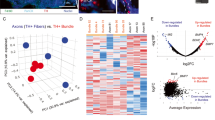Abstract
Background
PGP 9.5 is a cytoplasmic protein and is a specific marker for neurites and neurons.
Aims
Using anti-PGP 9.5, this study aimed to localize nerve fibers in normal colons, polyps, adenomas and adenocarcinomas.
Methods
Colonic polyps, adenomas and T1 to T3 adenocarcinomas with adjacent normal colon were immunostained for PGP 9.5 using rabbit anti-PGP 9.5.
Results
In normal colon, numerous nerve fibers were localized in inner and outer muscles, from which submucosa and lamina propria were innervated. In hyperplastic polyps and tubular adenomas, the stalk revealed Meissner’s plexus and large-diameter nerve fibers, and fine nerve fibers innervated abundantly in lamina propria of hyperplastic polyps and small tubular adenomas. In villous adenomas, large-diameter nerve fibers and Meissner’s plexus were localized in the stalk whereas a few or no fine nerve fibers were localized in fine stroma. In adenocarcinomas, more fine fibers were localized in submucosal stroma adjacent to the invading carcinoma in T1 carcinomas but there were no nerve fibers in the midst of tumors in T2 and T3 carcinomas. There were focally and sporadically increased nerve fibers adjacent to invading cancer nests in 5 of 8 T2 cases. In T3 carcinomas, fragmented Auerbach’s plexus were noted in cancer-invaded colonic muscles and there were no increased fine nerve fibers in the cancer-invaded subserosa in the majority of cases. PGP 9.5 immunostaining revealed tumor-associated neurogenesis in submucosa but no obviously increased nerve fibers within cancer-invaded muscles.
Conclusions
This lack of tumor-associated neurogenesis supports insidious and often silent clinical presentation of colonic carcinomas until invading through the colonic wall to adjacent organs.





Similar content being viewed by others
References
Hoyle CHV, Burnstock G. Neuronal populations in the submucous plexus of the human colon. J Anat. 1989;166:7–22.
Irwin DA. The anatomy of Auerbach’s plexus. Am J Anat. 2005;49:141–166.
Jackson P, Thompson RJ. The demonstration of new human brain-specific proteins by high two-dimensional polyacrylamide gel electrophoresis. J Neural Sci. 1981;49:429–438.
Thompson RJ, Doran JF, Jackson P, et al. PGP 9.5—a new member for vertebrate neurons and neuroendocrine cells. Brain Res. 1983;278:224–228.
Wilkinson KD, Lee KM, Deschpande S, et al. The neuron specific protein PGP 9.5 is a ubiquitin carboxyl-terminal hydroxylase. Science. 1989;246:670–673.
Karanth SS, Springall DR, Kuhn DM, et al. An immunocytochemical study of cutaneous innervations and the distribution of neuropeptides and protein gene product 9.5 in man and commonly employed laboratory animals. Am J Anat. 1991;191:369–383.
Michell BS, Schumacher U, Kaiserling E. Are tumours innervated? Immunohistological investigation using antibodies against the neuronal marker protein gene product 9.5 in benign, malignant and experimental tumours. Tumor Biol. 1994;15:269–274.
Chamary VL, Robson T, Loizidou M, et al. Progressive loss of perivascular nerve adjacent to colorectal cancer. Eur J Surg Oncol. 2000;26:588–593.
Compton CC. Colorectal carcinoma: diagnostic, prognostic, and molecular features. Mod Pathol. 2003;16:376–388.
Sobin LH, Wittekind CH. Colon and rectum. In: Sobin LH, Wittekind CH, eds. TNM Classification of Malignant Tumours. Geneva: Wiley, UICC; 2002:72–76.
Tomita T. Immunocytochemical localization of lymphatic vessels in colonic polyps and adenomas. Dig Dis Sci. 2008;53:1880–1885.
Vonlaufen A, Wiedle G, Borisch B, et al. Integrin alpha beta expression in colon carcinoma correlates with survival. Mod Pathol. 2001;14:1126–1132.
Zimmerman RL, Ross HM, Causas RE. Identification of lymphatic vessels in malignant, adenomatous and normal colonic mucosa using the novel D2–40. Oncol Rep. 2004;11:47–50.
Rmali KA, Puntis CA, Jiang WG, et al. Tumour-associated angiogenesis in human colorectal cancer. Colorec Dis. 2006;9:3–14.
Sundlisaeter E, Dicko A, Sakariassen O, et al. Lymphangiogenesis in colorectal cancer- prognostic and therapeutic aspects. Int J Cancer. 2007;121:1401–1409.
Fujita S, Nakanisi Y, Taniguchi H, et al. Cancer invasion to Auerbach’s plexus is an important prognostic factor in patients with pT3-pT4 colorectal cancer. Dis Colon Rectum. 2007;50:1860–1866.
Yamazaki T, Hibi K, Takase T, et al. PGP9.5 as a marker for invasive colorectal cancer. Clin Cancer Res. 2002;8:192–195.
Martin R, Fraile B, Peinadeo F, et al. Immunohistochemical localization of PGP 9.5, ubiquitin and NPY immunoreactivities in epithelial and neuroendocrine cells from normal and hyperplastic human prostate. J Histochem Cytochem. 2000;48:1121–1130.
Liblich A, Cross SS, Catto JWF, et al. Human prostate cancer cells express neuroendocrine cell marker PGP 9.5 and chromogranin A. Prostate. 2007;67:1761–1769.
Ansari P. Acute abdominal pain. In: Porter RS, Kaplan JL, eds. Merck Manual of Diganosis and Therapy. Whitehouse Station, NJ: Merck and Company; 2007:1–6.
Cappell MS. Pathophysiology, clinical presentation and management of colon cancer. Gastroenterol Clin NA. 2008;37:1–24.
Acknowledgments
I sincerely thank Dr Ov Slayden for allowing me to use his research laboratory to perform immununocytochemical staining at Reproductive Science Division, Oregon National Primate Center, Beaverton, OR. This study was supported in part by ONRRC Core Grant NIH RR 000163.
Author information
Authors and Affiliations
Corresponding author
Rights and permissions
About this article
Cite this article
Tomita, T. Localization of Nerve Fibers in Colonic Polyps, Adenomas, and Adenocarcinomas by Immunocytochemical Staining for PGP 9.5. Dig Dis Sci 57, 364–370 (2012). https://doi.org/10.1007/s10620-011-1876-7
Received:
Accepted:
Published:
Issue Date:
DOI: https://doi.org/10.1007/s10620-011-1876-7




